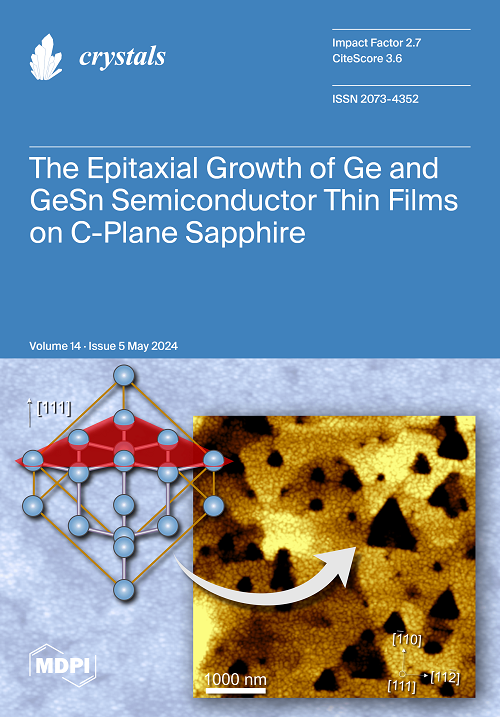Pulsed Laser Polishing of Zirconia Ceramic Microcrack Generation Mechanism and Size Characterization Study
IF 2.4
4区 材料科学
Q2 CRYSTALLOGRAPHY
引用次数: 0
Abstract
In order to study the mechanism of microcrack generation in the process of pulsed laser polishing of zirconia ceramics and the influence of laser polishing process parameters on the surface temperature and surface stress, this paper establishes a finite element computational model of pulsed laser polishing of zirconia ceramics based on the COMSOL Multiphysics multi-physics field simulation software. Firstly, in the process of establishing the finite element model, the temperature field and stress field coupling is used to analyze the temperature field and stress field changes during the laser polishing process, which reveals the microcrack generation mechanism and size characteristics of zirconia ceramics in the process of pulsed laser polishing. Secondly, through parameterized scanning, the variation rules of surface temperature and surface stress were studied under different process parameters of laser power, scanning speed, pulse frequency and pulse width. Finally, the validity of the finite element calculation model is verified by the pulsed laser polishing zirconia ceramics experiment. The results show that, in a certain energy range, the high-energy laser beam can effectively reduce the surface roughness of the material, and with the increase in the time of laser action on the surface layer of the material, it will cause the temperature and thermal stress of the surface layer of the material to continue to accumulate, and when the stress value exceeds the yield limit of the material, cracks will form in the surface layer of the material; because the laser power, scanning speed, pulse frequency and pulse width are used to affect the laser energy density, and then, the pulse width will be affected by the process parameters of the laser energy density, and thus the surface temperature and thermal stress of the surface layer of the material. Because the laser power, scanning speed, pulse frequency and pulse width all affect the thermal stress on the material surface by influencing the laser energy density acting on the material surface, the laser energy density is the main influencing factor of the dimensional characteristics of the microcracks. In addition, the microcrack width and depth will increase when the laser energy density acting on the material surface layer increases.脉冲激光抛光氧化锆陶瓷微裂纹生成机理与尺寸特征研究
为了研究氧化锆陶瓷脉冲激光抛光过程中微裂纹的产生机理以及激光抛光工艺参数对表面温度和表面应力的影响,本文基于COMSOL Multiphysics多物理场仿真软件建立了氧化锆陶瓷脉冲激光抛光的有限元计算模型。首先,在建立有限元模型的过程中,利用温度场和应力场耦合分析了激光抛光过程中温度场和应力场的变化,揭示了脉冲激光抛光过程中氧化锆陶瓷微裂纹的产生机理和尺寸特征。其次,通过参数化扫描,研究了激光功率、扫描速度、脉冲频率和脉冲宽度等不同工艺参数下表面温度和表面应力的变化规律。最后,通过脉冲激光抛光氧化锆陶瓷实验验证了有限元计算模型的有效性。结果表明,在一定能量范围内,高能激光束能有效降低材料的表面粗糙度,随着激光作用于材料表层时间的增加,会使材料表层的温度和热应力不断累积,当应力值超过材料的屈服极限时,材料表层就会形成裂纹;因为激光功率、扫描速度、脉冲频率和脉冲宽度是用来影响激光能量密度的,而脉冲宽度又会受到激光能量密度工艺参数的影响,进而影响材料表层的表面温度和热应力。由于激光功率、扫描速度、脉冲频率和脉冲宽度都会通过影响作用于材料表面的激光能量密度来影响材料表面的热应力,因此激光能量密度是微裂纹尺寸特征的主要影响因素。此外,当作用于材料表层的激光能量密度增加时,微裂纹的宽度和深度也会增加。
本文章由计算机程序翻译,如有差异,请以英文原文为准。
求助全文
约1分钟内获得全文
求助全文
来源期刊

Crystals
CRYSTALLOGRAPHYMATERIALS SCIENCE, MULTIDIS-MATERIALS SCIENCE, MULTIDISCIPLINARY
CiteScore
4.20
自引率
11.10%
发文量
1527
审稿时长
16.12 days
期刊介绍:
Crystals (ISSN 2073-4352) is an open access journal that covers all aspects of crystalline material research. Crystals can act as a reference, and as a publication resource, to the community. It publishes reviews, regular research articles, and short communications. Our aim is to encourage scientists to publish their experimental and theoretical results in as much detail as possible. Therefore, there is no restriction on article length. Full experimental details must be provided to enable the results to be reproduced. Crystals provides a forum for the advancement of our understanding of the nucleation, growth, processing, and characterization of crystalline materials. Their mechanical, chemical, electronic, magnetic, and optical properties, and their diverse applications, are all considered to be of importance.
 求助内容:
求助内容: 应助结果提醒方式:
应助结果提醒方式:


